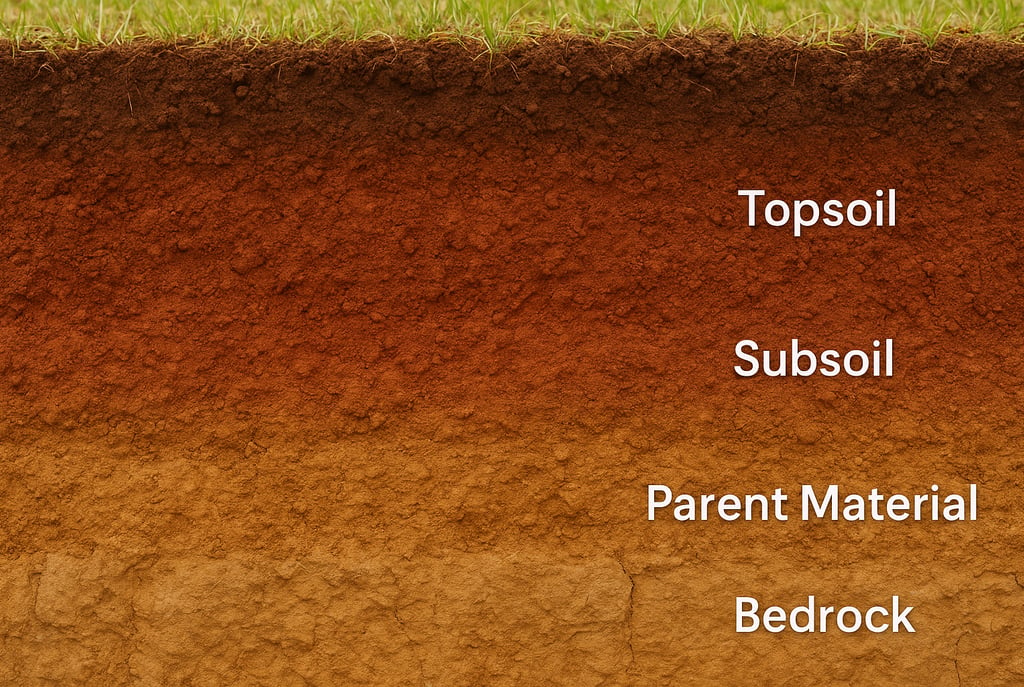Soil Profiles : A Comprehensive Guide
Soil profiles are a fundamental concept in soil science, representing a vertical section of the soil that showcases its distinct layers, known as horizons. Each horizon exhibits unique characteristics that reflect the processes of soil formation and the interaction of biological, chemical, and physical components.
SOIL HEALTH & FERTILITY
8/27/20258 min read


Introduction to Soil Profiles
Soil profiles are a fundamental concept in soil science, representing a vertical section of the soil that showcases its distinct layers, known as horizons. Each horizon exhibits unique characteristics that reflect the processes of soil formation and the interaction of biological, chemical, and physical components. Understanding soil profiles is essential, as they provide crucial insights into the soil's composition, structure, and nutrient content, which are vital considerations in agriculture, environmental studies, and land use planning.
A typical soil profile consists of several layers, generally identified as the O-horizon (organic layer), A-horizon (topsoil), E-horizon (eluviation layer), B-horizon (subsoil), C-horizon (parent material), and R-horizon (bedrock). The O-horizon is rich in organic matter, primarily composed of decomposed leaves and plant material, while the A-horizon is where most biological activity occurs, making it fertile and suitable for plant growth. The E-horizon often exhibits leaching, where minerals and nutrients are washed away, leading to a lighter color compared to the other horizons.
As we move deeper, the B-horizon accumulates materials that have leached down from above, enhancing its density and mineral content. These characteristics are critical for farmers and land managers, as they influence drainage, erosion potential, and nutrient availability. The C-horizon consists of partially disintegrated rock and minerals, contributing to the soil's overall stability and providing a reservoir for water and nutrients. Lastly, the R-horizon represents the unweathered bedrock beneath the soil mantle.
Grasping the dynamics of soil profiles is indispensable for various applications, from improving agricultural practices and boosting crop yields to effectively managing natural resources and implementing sustainable land use strategies. By analyzing soil profiles, scientists and land managers can tailor practices that enhance soil health, promote biodiversity, and ensure the sustainability of our environment for future generations.
The Layers of Soil: Horizons Explained
The soil profile is a critical component of land and ecosystem management, providing essential information about soil development and functions. Soil consists of distinct layers known as horizons, each serving particular functions and having unique characteristics. The primary horizons include the O, A, E, B, C, and R layers.
The first layer, the O horizon, is primarily composed of organic matter such as decomposed leaves and other plant material. This uppermost layer is generally dark in color and is rich in nutrients, making it vital for plant growth. Its primary function is to support the initial stages of the soil development process and offer habitat for organisms such as insects and microorganisms.
Beneath the O horizon lies the A horizon, often referred to as topsoil. This layer contains a mixture of organic material and minerals, providing a fertile ground for plant life. The A horizon is crucial for sustaining agricultural productivity, as it retains moisture and nutrients essential for crop growth. Its rich biological activity greatly influences the soil's fertility and health.
The E horizon, or eluviation layer, is characterized by the leaching of minerals and organic matter, resulting in a lighter color compared to the A horizon. It represents a transitional layer where materials are removed through movement, impacting nutrient availability in the lower layers and boosting the efficiency of the soil profile in nutrient transfer.
The B horizon, or subsoil, is rich in minerals that have leached from the above layers, such as iron, clay, and aluminum. This layer plays a significant role in water retention and drainage, acting as a reservoir of nutrients essential for deeper root systems. Its importance cannot be understated, as it directly contributes to plant health and stability.
The C horizon consists of weathered rock and mineral material. This layer provides insights into the geological history of the area and influences the overall soil composition. Finally, the R horizon, or bedrock, forms the base of the soil profile and is crucial for determining soil drainage and fertility.
Understanding these distinct soil horizons is essential for effective land management practices. Each layer contributes to the health and function of ecosystems, influencing everything from plant growth to water retention. Knowledge of soil profiles allows for informed decisions in agriculture, landscaping, and environmental conservation.
Soil Formation Processes
Soil formation is a complex process influenced by various factors, which collectively contribute to the development of distinct soil profiles. The primary processes involved in soil formation include weathering, organic matter accumulation, and the interplay of climatic and biological factors. Understanding these processes is essential for comprehending how different soil horizons emerge and interact.
Weathering is the physical and chemical breakdown of rocks and minerals, a critical initial step in the soil formation process. This can occur through various mechanisms, such as freeze-thaw cycles, temperature changes, and chemical reactions with water and atmospheric gases. As rocks disintegrate, they release minerals, which, along with fine particles, eventually form the initial components of soil. The rate and type of weathering are highly influenced by climate and geographic factors, leading to the development of specific soil characteristics in different regions.
Another significant process in soil formation is the accumulation of organic matter. Organic matter originates from the decomposition of plant and animal materials, which enriches the soil with nutrients and enhances its structure. This process is vital for soil fertility, as humus—a dark, organic component—improves water retention and promotes microbial activity. The amount and type of organic matter in the soil can vary based on ecological conditions, including vegetation type and land use practices.
Moreover, climatic factors such as temperature, precipitation, and humidity play a notable role in soil formation. For instance, wet climates generally promote faster weathering and greater organic matter accumulation, while arid climates may yield soils with low organic content and slower formation rates. Biological factors, encompassing flora, fauna, and microorganisms, further influence the dynamics of soil formation, affecting nutrient cycling, compaction, and horizon development. Understanding these processes is essential for effective soil management and conservation efforts.
Soil Properties: Physical and Chemical Characteristics
Soil properties can be broadly categorized into physical and chemical characteristics, both of which play a crucial role in defining soil profiles and their overall health. Understanding these properties is essential for effective land management and agricultural productivity.
The physical properties of soil include texture, structure, moisture content, and bulk density. Soil texture refers to the relative proportions of sand, silt, and clay minerals, which significantly influence water retention, aeration, and root penetration. For instance, sandy soils tend to drain quickly and may require more frequent irrigation, whereas clay soils can retain moisture but may suffer from drainage issues. Soil structure, on the other hand, pertains to the arrangement of soil particles into aggregates. Well-structured soil enhances water infiltration and root growth, contributing positively to plant development.
Moisture content is another vital physical property that impacts soil productivity. The balance between water retention and drainage determines nutrient availability and microorganism activity within the soil, which are essential for healthy plant growth. Additionally, bulk density, defined as the mass of soil per unit volume, reflects soil compaction. High bulk density can impede root growth, limit water infiltration, and restrict the movement of nutrients.
In summary, both physical and chemical properties of soil are integral to understanding soil profiles and their implications for agricultural productivity and ecosystem health. Recognizing and managing these properties can lead to improved soil management practices and sustainable land use.
Soil Profile Analysis and Assessment
Soil profile analysis and assessment are essential components in understanding the characteristics and composition of soil layers. These methods provide valuable insights into soil health, fertility, and potential issues affecting land use. A systematic approach to soil profile assessment typically begins with soil sampling techniques, which can vary according to the objectives of the analysis. Common methods include random sampling, systematic sampling, and grid sampling, each serving different purposes and providing unique insights into soil variability.
In addition to sampling techniques, laboratory analyses play a crucial role in determining soil properties. Key analyses may include the examination of soil texture, pH, organic matter content, nutrient levels, and moisture retention capacity. For instance, texture analysis can reveal the proportion of sand, silt, and clay within the soil, informing decisions related to agricultural practices or construction projects. Furthermore, pH levels are critical in identifying soil suitability for various crops, helping to guide amendments necessary for optimal growth.
Field observations complement laboratory results and encompass visual assessments of soil color, structure, and biological activity. Factors such as soil erosion, compaction, and drainage characteristics can also be evaluated through in-field observations. These evaluations are vital in agriculture, as they directly affect crop yield potential and management strategies. Similarly, in construction and environmental management, understanding soil profiles ensures that projects are sustainable and risks are mitigated effectively.
The importance of soil profile assessment cannot be overstated, as it serves as the foundation for informed decision-making across various domains. Understanding the complexities of soil profiles allows stakeholders to develop tailored strategies for sustainable land use, ultimately promoting productivity and environmental stewardship.
The Role of Soil Profiles in Ecosystems
Soil profiles play a pivotal role in various ecosystems, acting as the foundation for a multitude of ecological processes. Each profile consists of distinct layers, or horizons, that contribute uniquely to the environment. One of the crucial functions of these profiles is water filtration. As water percolates through the soil layers, contaminants and particulates are naturally filtered out, ultimately leading to cleaner water entering the groundwater systems. This filtration process not only aids in maintaining water quality but also supports the overall health of aquatic ecosystems.
Additionally, soil profiles are vital for carbon sequestration, a process through which carbon dioxide is captured and stored in the soil. Rich organic matter within the topsoil, particularly in forested and grassland ecosystems, plays a significant role in absorbing carbon. Through photosynthesis, plants contribute to soil carbon stocks, thus mitigating the impacts of climate change. This function of soil profiles is particularly important in combatting global warming, as soils are one of the largest carbon sinks on Earth.
Furthermore, the ecological significance of soil profiles extends to supporting biodiversity. Various organisms, from bacteria to larger fauna, rely on the characteristics of specific soil layers for habitat and sustenance. Different soil types promote the growth of diverse plant species, which in turn provide food and shelter for a wide range of animal species. This intricate web of interdependence ensures the stability and resilience of ecosystems, allowing them to adapt to environmental changes.
In summary, the role of soil profiles is critical within ecosystems, underlining their importance in processes such as water filtration, carbon sequestration, and fostering biodiversity. Understanding these connections enriches our appreciation of soil health and its implications for environmental sustainability.
Conservation and Management of Soil Profiles
The conservation and management of soil profiles play a pivotal role in sustaining agricultural productivity and ecological balance. Effective practices are essential for maintaining healthy soil profiles, particularly in the face of challenges such as erosion, degradation, and climate change. Sustainable agriculture serves as a critical approach in this regard, promoting techniques that enhance soil health while minimizing environmental impacts. These practices include crop rotation, cover cropping, and the integration of organic matter, which collectively contribute to soil structure and fertility.
Erosion control is another vital aspect of soil profile management. Soil erosion, caused by water and wind, can lead to significant loss of topsoil, reducing the soil's capacity to retain nutrients and moisture. Implementing erosion control measures, such as terracing, contour farming, and the establishment of buffer strips, helps to mitigate these risks. These strategies not only protect the soil from degradation but also enhance biodiversity by promoting a more resilient ecosystem.
Land restoration efforts also play an important role in soil conservation. Techniques such as reforestation, wetland restoration, and the rehabilitation of degraded land can restore soil profiles to their natural state. These efforts are crucial for combating the effects of climate change, which poses increasing threats to soil health worldwide. With rising temperatures and altered precipitation patterns, maintaining soil integrity becomes even more critical. Implementing adaptive land management strategies can help to buffer the impacts of climate change on soil health, ensuring resilient agricultural systems and ecosystems.
Overall, the conservation and management of soil profiles are indispensable for fostering sustainable practices and mitigating environmental challenges. By adopting effective soil management techniques, societies can safeguard their agricultural resources and promote the long-term health of their ecosystems.






"Boosting Crop Growth With Nature's Power"
Contact Us:
E Mail: support@frosil.com
Customer Care: +91 8329592991
FROSIL © 2025. All rights reserved.


'Frosil' is a fertilizer manufacturer committed to enhancing soil health and crop yields. We provide high-quality, eco-friendly products that support sustainable agriculture and help farmers achieve optimal results.
Registered Office: Gat No.96, Near Krushnai Hospital, Tandali. Tal- Shirur, Dist- Pune.
